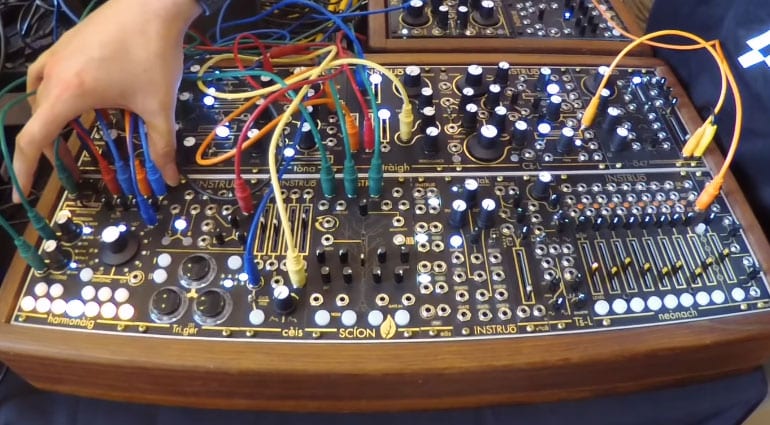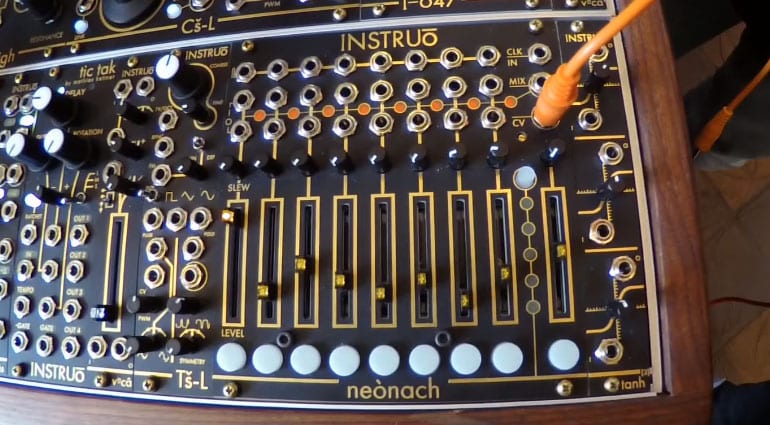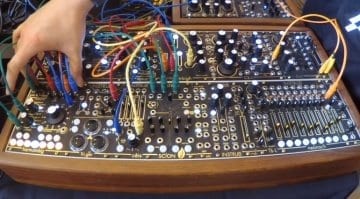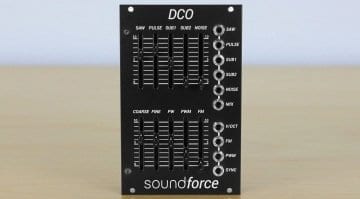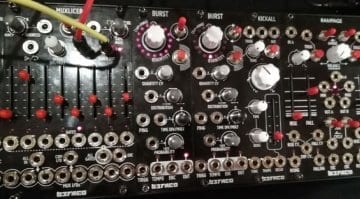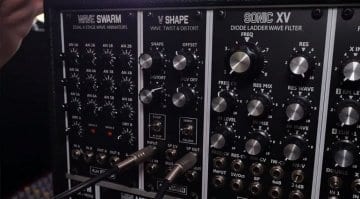Superbooth 2018: Instruó introduce us to a load of new modules
Instruó have been making elegant boutique modules in Scotland for some time now. They have been only making them to order and tend to neglect their website and so have been a little frustrating to those of us who like to window shop and dream about future purchases. However, they’ve started making their modules more generally available for sale and you can buy them (mostly) direct online – hooray! Jason from Instruó took Superbooth as an opportunity to tell us all about their range of modules.
Harmonáig
We have seen this one about previously. Harmonáig is a quantizer for harmonic patching. From a single CV signal it will generate 4 harmonised intervals consisting of the root, 3rd, 5th and 7th that you plug into 4 independent oscillators. The interface allows you to dial in different chord types, inversions and play with the voicing. You can sweep through modalities and chord voicings, browse through harmonies and chord progressions and you don’t even have to know what you’re doing. You can control everything with CV, or use the button keyboard to perform all your changes on-the-fly. The key to the musicality of Harmonáig is that it will always pick the most diatonically relevant chord regardless of what key you’re in. There’s a whole world of complex harmonic progressions in this little 18hp box.
Harmonáig is available now for £300.
You are currently viewing a placeholder content from Default. To access the actual content, click the button below. Please note that doing so will share data with third-party providers.
Tóna
A single voice all sawtooth core analogue oscillator with the classic waveform outputs plus a wavefolder output for some added harmonic interest. “The wavefolder is derived from classic west coast ‘timbre’ circuits and opens up a world of rich harmonics and complex spectra, adding a touch of west coast flavour to any subtractive synth voice.”
It has a really nice slider to control the wavefolding which can also be CV controlled. There’s a linear FM input with an attenuator and hard sync.
Tóna is available now for £190.
You are currently viewing a placeholder content from Default. To access the actual content, click the button below. Please note that doing so will share data with third-party providers.
Ts-L
This small form factor module is a triangle core analogue oscillator with 5 unique outputs. Alongside the sine and triangle is a square wave sub at 1 or 2 octaves below the main oscillator. Then there’s the PWM output that generates two waveforms that can be crossfaded between:
With the the blent pot fully clockwise, the waveform will form a double pulse shape in which the high and low pulse’s widths can be defined by the pot and/or an external CV signal. This waveform crossfades to a unique split triangle shape that is shaped by the same pulse width control signal.
The final output is a wavefolder like in the Tóna but with controls over symmetry as well as depth making it much more aggressive. Usual things like FM and sync (soft) inputs are also present.
Ts-L is being made in small batches so you’ll need to ask about lead times. Yours for £250.
You are currently viewing a placeholder content from Default. To access the actual content, click the button below. Please note that doing so will share data with third-party providers.
Cs-L
The big brother of the Ts-L . Cs-L is a dual analogue oscillator. The top half is a sawtooth core, derived from the Toná, the bottom half is the triangle core from the Ts-L. It’s like taking everything they’ve learned so far and crafted it into a single module. Both halves of the module have their own wavefolder and they each have different waveform outputs. A four-quadrant multiplier stage allows for ring modulation as well as rectification and amplitude modulation. There’s a lot of potential for cross modulation.
The idea was to move away from the traditional complex oscillator of defined carrier and modulator and instead allow everything to flow into everything else. So you can modulate in either direction. It’s like using two distinct oscillators to mess with each other. Feedback one oscillator into the FM of the other, or the symmetry, or the wavefolder – stuff like that. All this can happen without patching in a single cable. The top oscillator has an LFO switch to bring it down to modulation speeds.
Complex and interesting – check out the video at the bottom of the article to get into the craziness – there’s a lot of fun to be had.
Cs-L will be available soon in small batches for £510.
You are currently viewing a placeholder content from Default. To access the actual content, click the button below. Please note that doing so will share data with third-party providers.
I-ó47
A multimode filter based on the ARP 2500 1047 resonant filter. Instruó have added a variable notch filter with CV control. You get outputs on all four modes. The main input has a gain control and limiter built-in. This will push a triangle into a sort of S-shaped curve or give a sense of fattening to more complex signals. The secondary input inverts the signal and is responsive to the resonance. The resonance can push it into stable self-oscillation and there’s a 1volt/oct and FM input with attenuation.
The I-ó47 is not on the website yet.
You are currently viewing a placeholder content from Default. To access the actual content, click the button below. Please note that doing so will share data with third-party providers.
Neónach
Another module that hasn’t reached the website yet is Neónach (which translates to “weird”) which they describe as an “ongoing work in progress”. It was created as a commission to build a bunch of faders that send out CV to control stuff. But they decided to build other things in. So it has an input/output per fader which turns it into a mixer. An analogue slew limiter for the input and the fader. Gate outputs at the top are manually triggered via the buttons. You can create sub-groups for mixer on some faders and CV on others, there are mute switches a simple sequencer – all sorts of stuff. And they are open to suggestions on more functionality.
If that interests you then Jason suggests that you get in touch.
Other modules
The website does have a couple of others not mentioned in DivKids video below including the Scion plant CV module and the Aithér wireless OSC module which we’ve seen before and the Tráigh transistor LPF which we haven’t. There’s also an impressive looking module called the Sinfonión by Mathias Ketner. It’s an 8 channel quantizer designed to pull all your voices together into some kind of musical, usable, playable whole. There’s a very interesting video about on the product page.
There’s something about the combination of the look of Instruó modules and their intention which gives of a very pleasing vibe. There’s a sense of musical experimentation and beauty behind these modules. I am currently hovering over the “BUY” buttons on the website and wondering if I’m going to have to buy a new rack.
More information
- Instruó website shop.
Video
You are currently viewing a placeholder content from YouTube. To access the actual content, click the button below. Please note that doing so will share data with third-party providers.

